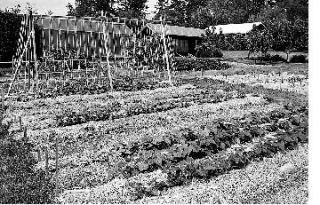Maybe it comes from growing up in New England eating baked beans in the winter and shell beans in the summer, but for as long as I’ve had a garden I’ve grown beans, not for the pods but for the seeds inside. Occasionally I’ll meet another bean lover and we’ll talk like long-lost relatives, members of the happy family of bean growers and eaters. Lately, with current interests in local food and food security, I’ve met other gardeners who want to join the bean family. Here’s what I share from my experience with varieties, planting, shelling and eating.
Beans are distinguished both by growth habit—bush or pole—and by the stage when you harvest them—shell or dry. Bush beans grow to a manageable two feet tall while pole beans grow to eight feet or more and need sturdy support. Shell beans are ready when the pods are full but still flexible and the beans inside aren’t yet dry, late July and into August from seeds planted in mid-May.
Dry beans are ready when both the pods and the beans inside are hard and dry, usually September from mid-May plantings. Any bean can be eaten at the shell stage or left to dry, but to me, some varieties taste best as shell, others as dry, and some tasty either way.
In my garden, the bush beans black turtle and cannellini seem best left to dry, flageolet is delicious as a shell or a dry, but cranberry is the perfect shell bean. Of the pole beans, my standard has been white runner. It tastes like lima beans when eaten fresh and like chestnuts as a dry bean.
Looking for new tastes, each year I add a few varieties. Favorites from 2009 were bush beans Indian Woman Yellow, excellent dry, and Tiger’s Eye great as shell and dry; and pole bean Golden Lima, amazing as a shell bean.
When I’m not simply replanting saved seed of my favorites, sources I use for bean seeds are Fedco www.fedcoseeds.com/seeds.htm, and Seed Savers Exchange www.seedsavers.org, because of their extensive collections and helpful descriptions. And there are always friends who are willing to share their favorites.
Of all the tips I’ve gotten over the years, the one that yields the best bean germination is to set the bean seed in the ground so that the “eye” or “bellybutton,” technically the hilum, is facing down.
Such precision planting is only for the fanatic home gardener, but it really does work. Cover the just planted seeds with Reemay so that robins won’t see the germinating seeds breaking the soil, think they are worms and methodically pull each one out.
Whether shell or dry, the beans are in a pod and need to be shelled. My father piled dry soldier bean plants with pods still attached into a huge barrel and then lifted each of us kids in turn into the barrel where we’d jump up and down, releasing the beans from the pods. Then on a windy day, we’d winnow the beans from the crushed pods and plants.
For shell beans, my mother and a neighbor used the wringer of an old washing machine, turning the wringer to split the pods open and send the beans into the washer tub.
For my much smaller-scale operation, I usually pull the pods from the plants and find a comfortable spot to sit and shell them. My sister commandeers friends or visiting guests to help her with shelling and it is a great social event, but shelling beans is also a lovely solitary task.
Hummus made from white runners, black beans with dried tomatoes and caramelized onions, flageolets with sautéed leeks, cannellini with sage and garlic, and all manner of bean soups feed us in winter.
Dried beans are wonderful, but if I had to choose, I’d pick shell beans. Added to corn, they become succotash, one of my favorite meals. Toss them with tomatoes and basil or summer savory, with grains like emmer farro, or even with their cousins green or yellow pod beans. Or enjoy them with just a light coating of olive oil and some salt and pepper.
Plant a few beans this year and you may find you’ve joined the bean family too.



